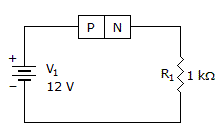Electronics - Semiconductor Principles - Discussion
Discussion Forum : Semiconductor Principles - General Questions (Q.No. 24)
24.
What is the voltage across R1 if the P-N junction is made of silicon?


Discussion:
23 comments Page 1 of 3.
Aravind said:
9 years ago
The silicon has 0.7 voltage barrier. So it blocks 0.7v from load source.
Therefore 12-0.7 = 11.3.
Likewise, germanium has 0.3 voltage barrier. therefore if PN junction is germanium then the answer will be 11.7.
Therefore 12-0.7 = 11.3.
Likewise, germanium has 0.3 voltage barrier. therefore if PN junction is germanium then the answer will be 11.7.
Akanksha said:
1 decade ago
As the forward bias Si P-N Junction produces a barrier voltage of 0.7 V. Barrier voltage will oppose forward biasing voltage 12V .
That's why 12-0.7 = 11.3V is the answer.
That's why 12-0.7 = 11.3V is the answer.
RAPHAEL CHINEDU IKEM said:
9 years ago
0.7 is the voltage drop for silicon diode.
So when the 13V pass through the silicon diode, there will be a voltage drop of about 0.7V
i.e 13 - 0.7 = 12.3V.
So when the 13V pass through the silicon diode, there will be a voltage drop of about 0.7V
i.e 13 - 0.7 = 12.3V.
Teja said:
8 years ago
The diode is silicon or germanium is not mentioned in the question so how can you guess if it is germanium (Ge) cutoff voltage 0.3? then answer is 11.7v.
Masud Alom said:
8 years ago
The diode cutoff voltage is 0.7 volts for silicon.
So the remaining voltage of input will be obtained at the output i.e., 12-0.7 = 11.3V.
So the remaining voltage of input will be obtained at the output i.e., 12-0.7 = 11.3V.
(2)
Kalyan polu said:
9 years ago
The diode cutoff voltage is 0.7 volts for silicon. So the remaining voltage of input will be obtained at the output i.e., 12-0.7 = 11.3v.
Gopal verma said:
1 decade ago
But resistance in kilo ohms and voltage in volts so both are different in systems. Answer should be 11.3 * 10 to the power -3.
Saichaitanya said:
1 decade ago
@Meena/ Santosh - Why the difference have been considered here (i.e. 13-0.7), since the voltage have to be added in series?
REYAZUDDIN ALAM said:
9 years ago
We know that break down voltage of si = 0.7v.
Silicon will consume 0.7v.
So, voltage across r1= 12.0.7 = 11.3v answer.
Silicon will consume 0.7v.
So, voltage across r1= 12.0.7 = 11.3v answer.
Karthika said:
7 years ago
SI cut off voltage is 0.7.
Load voltage is 12.
So, the voltage across 1ohm resistor is VR=vl-vsi=12-0.7 = 11.3.
Load voltage is 12.
So, the voltage across 1ohm resistor is VR=vl-vsi=12-0.7 = 11.3.
(1)
Post your comments here:
Quick links
Quantitative Aptitude
Verbal (English)
Reasoning
Programming
Interview
Placement Papers